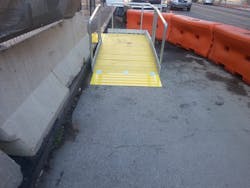City of Columbus tests PSS BoardWalk Temporary Ramp
In our March 2014 Roads & Bridges Case of the Week, we featured Paul Peterson Co., Columbus, Ohio, and their efforts to help municipalities improve pedestrian safety in sidewalk work zones.
In that case study, we relayed why Peterson Co. deployed SafetyWall ADA-Compliant Pedestrian Channelizer in a sidewalk work zone in the city of Columbus.
Gary Boylan, vice president of Peterson Co., described a municipality’s impetus to make pedestrian work zones ADA-Compliant.
“Cities want to upgrade their pedestrian work zones for their streets,” Boylan said. “They want them safer, and less confusing to pedestrians. They want people to get through easily and quickly, and they don’t want anybody to get hurt.”
A little over a year later, Peterson Co. returned to the city of Columbus with another solution to a long-standing problem in pedestrian work zones.
The problem pedestrians encounter, especially pedestrians with limited vision and mobility issues, is an alternate pathway that requires them to negotiate a change in elevation, such as a curb.
For example:
- A street crossing is closed, and the pedestrian pathway must be re-routed. The alternate pedestrian pathway is routed to a temporary crosswalk, which usually includes a curb, if the temporary crosswalk is mid-block; or
- The sidewalk itself is closed, and the alternate pathway takes pedestrians into the curb lane to get around the sidewalk construction. Pedestrians usually will encounter a curb in their pathway to the curb lane.
(See detail below of “Sidewalk Diversion”, from Figure 6H-28, MUTCD, 2009 Edition)
Now, pedestrians with normal vision and full ability to walk can usually negotiate a city curb. But this may preclude pedestrians with limited vision or mobility issues, and is thus a possible hazard for them.
Municipalities, sidewalk owners, general contractors and their sub-contractors must provide safe, continuous, detectable guidance through pedestrian work zones for all pedestrians.
How have curbs in alternate pathways been dealt with in the past?
Contractors generally have employed one of two informal methods:
- Fill the angle of the curb and street with asphalt; or
- Throw plywood on top of the curb.
Neither method satisfies ADA slope or minimum width requirements; both could be considered hazardous to all pedestrians.
When Andrew Wildman, Peterson’s sales and marketing manager, presented the city of Columbus with an engineered pedestrian safety device that provides pedestrians with safe passage over curbs, the city was very interested.
Wildman knew that the city was determined to make accessibility in pedestrian work zones more uniform for all pedestrians. They are also determined to make their work zones consistent, so that pedestrians know where to go, and what to do in any city work zone encountered.
“The city of Columbus is all about pedestrian safety, all about ADA-Compliance,” Wildman said.
Wildman introduced the city to BoardWalk Temporary Pedestrian Modular Ramp (TPMR), designed and manufactured by PSS (formerly Plastic Safety Systems).
BoardWalk TPMR provides accessible, detectable and safe guidance where access routes cross curbs. BoardWalk replaces curb transitions and temporary ramps that are not compliant.
As BoardWalk Ramp is temporary, and modular; it can be assembled and disassembled at will, and moved from location to location.
Wildman offered to install a demonstration BoardWalk Ramp at a location of the city’s choosing. The city determined to use a longer-term construction project, so they could observe how the ramp performed over time. They also wanted a site where there was a higher concentration of pedestrians with limited vision or mobility issues.
In December 2015, they selected a project that met the criteria: an 18-month construction project at High and Rich streets, in downtown Columbus, also sees a significant amount of pedestrians with limited vision and mobility issues.
Peterson installed a BoardWalk Ramp and Platform configuration, so it can guide pedestrians over the curb and into the curb lane. The ramp was oriented parallel to traffic.
“The city saw immediate benefits,” Wildman said.
Once installed, BoardWalk Ramp can be opened to pedestrians. At High and Rich streets, BoardWalk provided immediate and easily understood guidance for all types of pedestrians, those with or without vision, those who walk or use walking aids.
With the successful demonstration at High and Rich streets, Wildman has rented two BoardWalk Ramps for a Lane Avenue construction site.
“It’s an excellent piece,” Wildman said. “Safe for pedestrians, friendly to pedestrians, easy to install and relocate…BoardWalk is a win for everyone…pedestrians, the city, contractors and us.”
For more information, visit www.pss-innnovations.com, or call 800.662.6338.
